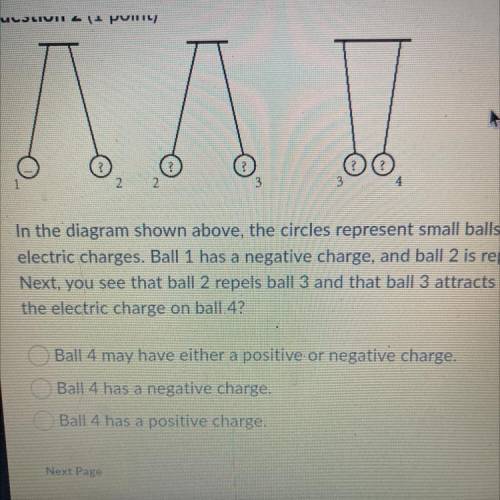
Physics, 29.01.2021 15:30 magicallyhello
In the diagram shown above, the circles represent small balls that have
electric charges. Ball 1 has a negative charge, and ball 2 is repelled by ball 1
Next, you see that ball 2 repels ball 3 and that ball 3 attracts ball 4. What is
the electric charge on ball 4?
Ball 4 may have either a positive or negative charge,
Ball 4 has a negative charge.
Ball 4 has a positive charge.


Answers: 2


Another question on Physics

Physics, 21.06.2019 17:30
The particles of an ice cube at 0°c (represented by the blue circles) come in contact with the particles of juan’s hand at 37°c (represented by the orange circles). which diagram correctly represents the temperature of the two substances and the direction of heat flow?
Answers: 3


Physics, 22.06.2019 20:40
Ablock of mass m = 2.5 kg is attached to a spring with spring constant k = 740 n/m. it is initially at rest on an inclined plane that is at an angle of theta= 26 with respect to the horizontal, and the coefficient of kinetic friction between the block and the plane is uk = 0.17. in the initial position, where the spring is compressed by a distance of d = 0.16 m, the mass is at its lowest position and the spring is compressed the maximum amount. take the initial gravitational energy of the block as zero. the block's initial mechanical energy is 9.472 j.b. if the spring pushes the block up the incline, what distance l in meters will the block travel before coming to rest? the spring remains attached to both the block and the fixed wall throughout its motion.
Answers: 3

Physics, 22.06.2019 21:00
What do the atoms of elements in the same group have in common? a. they have the same atomic numbers. b. they have the same average atomic masses. c. they have the same number of electron shells. d. they have the same number of electrons in their outermost shells.
Answers: 1
You know the right answer?
In the diagram shown above, the circles represent small balls that have
electric charges. Ball 1 ha...
Questions



Mathematics, 19.09.2019 02:30

English, 19.09.2019 02:30

Health, 19.09.2019 02:30

Mathematics, 19.09.2019 02:30

History, 19.09.2019 02:30

Chemistry, 19.09.2019 02:30


Health, 19.09.2019 02:30


Social Studies, 19.09.2019 02:30


Social Studies, 19.09.2019 02:30



Business, 19.09.2019 02:30

Physics, 19.09.2019 02:30

Business, 19.09.2019 02:30

Mathematics, 19.09.2019 02:30



